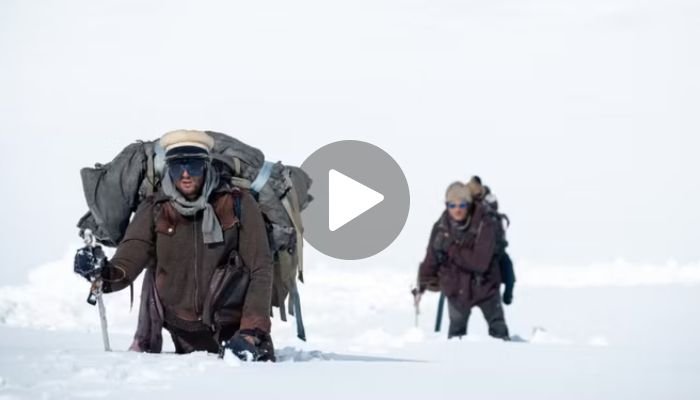
If you are looking for a snowy paradise in theaters this Christmas weekend, Society of the Snow (La sociedad de la nieve) is it — but be prepared to never want to see snow again. The film tells the incredible and horrifying true story of a Uruguayan rugby team that flew to Chile in 1972; what should have been a day-long flight aboard Uruguayan Air Force Flight 571 turned into a 72-day-long ordeal for the living, and a cold, vicious death for everyone else. Often called ‘the Miracle in the Andes,’ this movie puts a seminary student at center stage to examine the difference between miracles and nightmares, God and nature, and what it really means to survive.
Relentless is an understatement for Society of the Snow; it isn’t even 12 minutes before the plane crashes. After some necessary context, where we meet our brotherly rugby team amongst others like Numa Turcatti, an aspiring priest or theologian who is best friends with one of the players. Numa is played wonderfully by Uruguayan actor Enzo Vogrincic (though English actor Paul Syre does great work with the ridiculously good English voice dub); he narrates the film with poetry from deep thought after.
J.A. Bayona was born to direct this movie. Not only can he do action really well and use CGI properly (see A Monster Calls and Jurassic World: Fallen Kingdom among other things including his directing The Lord of the Rings: The Rings of Power), but he’s exceptional at suggesting horrific things within a more serious grounded context (see The Orphanage). Also — most importantly — he directed one of if not still the greatest disaster movies ever made: The Impossible starring Naomi Watts and Ewan McGregor (and Tom Holland in his first film) as they try to survive the 2004 Indian Ocean tsunami; which was also a true story about a close-knit group of people.
Bayona respects the real people he uses for his stories; this is not just a disaster spectacle but a film very interested in humanity and survival, especially when it makes you do terrible things. Society of the Snow is without question the best disaster movie we’ve seen in years. One might ask if this film was necessary given 1993’s Alive, which is considered a classic in the genre and tackles the same event. To that we would say The Society of the Snow is a much truer film, and not just because it’s Chilean/Uruguayan/Spanish. In every way possible it’s better — or at least different enough to be worth making another one like this.
The set piece is very fake looking with CGI, but it looks really real. This is due to the performances and a couple really impressive jump scares. The tail of the plane has broken off from the rest and the plane is almost completely buried in a frozen valley surrounded by mountains. When some passengers go on an expedition they see the body of the plane from quite a height and realize that its position would be nearly impossible for search planes to identify. They are somewhere in the Andes; everything is covered in feet of snow; there’s no food; it drops 80 degrees at night.
They collect everyone who died overnight, when people were screaming from different broken bones or injuries until they froze or passed out. At least they can feel warmth when the sun comes up. They’re resourceful young men. They tend to their wounded. They tear apart parts of the plane to make better shelter and hammocks for the wounded. They put up reflective material so that they can melt snow into bottles for drinking water. They go through all of their suitcases looking for food, cigarettes, liquor, warm clothes — anything that could keep them alive another day or two. There isn’t much.
They talk about the rule of threes — you can go three minutes without air, three days without water, three weeks without food; but with how many calories they’re burning trying to stay warm in freezing temperatures at such high altitude, it’s more like one week. It must be discussed eventually: if they’re going to survive, they have to eat.
In stead of being a mean or hate filled look into humans who resort to cannibalism The Society Of The Snow is far more kind hearted and understanding then one might expect While it is not pleasant watching these events unfold there are multiple moral arguments made by characters over time For there are things people do out of selflessness or principle But hunger does not care These are not bad people they are a team and they truly love each other They make it known that if any of them die others are welcome to eat their flesh
Numa is a holdout, mostly for religious reasons. He fights it until he’s almost dead. Vogrincic is incredible in this movie; so is the makeup from Ana López-Puigcerver and the hair styling from Belén López-Puigcerver. Numa seems to shrivel up and lose 80 pounds off his already slender frame over the course of weeks. His voice changes, his movements slow down, his eyes sink further back in his head. It’s an amazing transformation by great actor and crew. Vogrincic will be a star one day. He looks like a much hotter, more intense Adam Driver; I couldn’t take my eyes off him whenever he was on screen.
We notice the toll of the crash on others, and this movie reminds us painfully about it by keeping a count of deaths through the whole thing. What is the single most frustrating question anyone can ask when they are lost? It is should I stay or should I go now? If they stay, even after several planes fly right over them without seeing them, they will only be waiting for some plane or helicopter to find them. If they go, how many days and nights do they have to survive before they stumble upon any sign of life? But they are worse off the longer they wait. Society of Snow shows this hesitation and anger in such a subtle way that it’s brilliant.
Watch free movies on Fmovies







